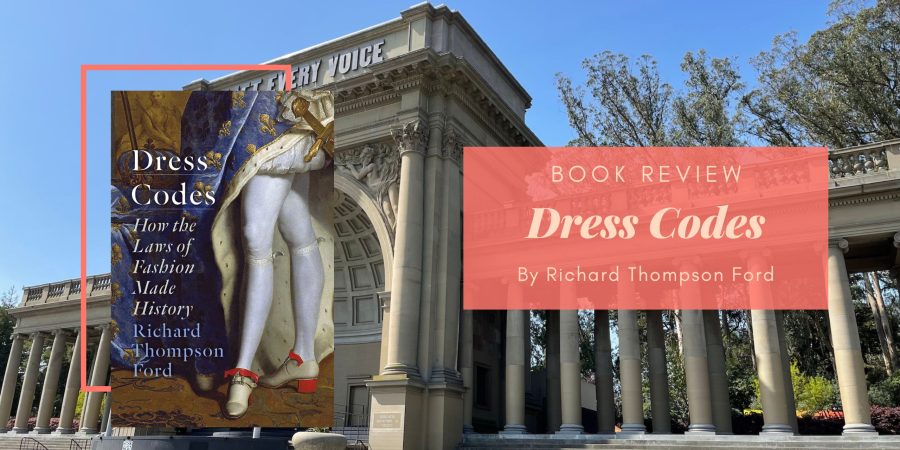Hello friends! After posting my update, I pretty much disappeared and basically, after a great honeymoon, I came back and immediately plunged into work – we are adopting new ERP software so that has pretty much consumed my waking hours. But I had a great trip and managed to read lots of books, so now that I’m starting to have some breathing room (thanks body for um… falling sick?!), I am going to restart posting book reviews and my Maldives trip posts! Stay tuned and now for the review:
I can’t quite remember how this book got on my radar, but after reading this, I think it would be a pretty good companion to books like Ametora (on Japan’s role in the development of Preppy style) and Liberty, Equality, Fashion (on the style icons of the French revolution). And while both these books seem very different in topic, they all have one thing in common: the role of fashion.
Dress Codes is a look at the intersection between fashion, status, and self, with lots of case studies from European history and modern history. At first, going by the cover image, I thought it was going to be a history book that covered the development of sumptuary laws in Europe but it actually looks at fashion from the following angles:
- As status symbols
- How style went from overstated luxury to understated elegance and what that says about class markers
- Fashion and race discrimination (including how taking on markers of middle class respectability worked in the fight for African American rights)
- How fashion works in gender roles, politics, work, and religion
There are actually five sections in the book in trying to sum them up, I think there are a few common themes that cross sections:
- Fashion and Power
- Fashion and sex/gender
- Fashion and race
Essentially, Thompson Ford is arguing that fashion is a marker and can be used to both enforce and push back against the status quo, depending on how it is used.
Here, I want to digress from the book and talk about a talk that I went for recently, titled “Folding, Unfolding, and Refolding – Transformations of Chinese skirts into Western fashion” by Professor Mei Mei Rado. During the FAQ session of the talk, the professor was asked if these western refashioning of Chinese/manchu clothing a form of appropriation that erases the original wearers. Here, Prof Rado pointed out that fashion’s fundamental essence is a collage of temporal and cultural essence and that the question of authenticity is always a question of cross cultural studies. How do we see objects as they move across cultures? Do we focus on the movement or one specific cultural context?
Reading some of the examples of cultural appropriation in Dress Codes, it’s clear that some are egregious and out of the pale (like the USA vs Mexico frat party that had stereotyped costumes and border patrol costumes) but some seem to be the movement of culture across borders – for example, Marc Jacobs’ fashion show with dreadlocks, or when an American high school student wore a Qipao to prom (reminds me of a recent BBC article about how African dresses are becoming popular as prom dresses in the US). It may be that we all need to know more about how dress codes function, so that we can tell when someone is using fashion in a way to mock and oppress or when fashion is evolving and perhaps taking on a different shape from its traditional form (I’m also thinking of how a lot of modern hanfu is essentially a fusion of Chinese and Western ways of dressing and how the hanfu trend in general would not be accepted in past dynasties, showing a change in how we view these clothes).
Overall, I found Dress Codes to be an interesting look at how fashion functions in society. While it’s really focused on Western and American contexts, I think the idea of fashion as a tool to signal one’s status or to transgress certain boundaries is one that can be applied across different cultural contexts and I would definitely be thinking of this book the next time I’m reading a history book about clothes!

Sounds good!
I would just add that we should not assume that a person knows what they are saying with their clothes, especially in the case of young people, and especially in individualistic cultures where what we wear is not prescribed or explained to us as children. They might wear something that is in poor taste, but not be intending to disrespect anyone. Young women, at least in the U.S., are often immodest without realizing it. If they can’t even tell when they are being provocative, how much less will they be able to anticipate that someone will think they are making some kind of cultural statement!
I’m so glad you had a good honeymoon!
Thanks (about the honeymoon statement). And yes, the book does talk a bit about how some people don’t realise there are this dress codes and are therefore unfairly penalised about it. I realised that it’s all very complicated and I agree that we shouldn’t assume that people always know what signals they are sending out with their outfit.
It’s a pity that this is so western focused but it sounds utterly fascinated in what it does offer!
It’s definitely fascinating! I suppose I have high expectations, since America isn’t my default frame of reference, so I always feel the need to mention that lol